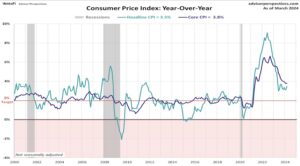The Consumer Price Index (CPI), which measures inflation, surprised economists Wednesday morning by coming in higher than expected.
CPI (which is a measure of prices of goods and services in the entire economy) rose by 0.4 percent during the month. This puts the inflation rate for 12 months at 3.5 percent. This is 0.3 points higher than February, and also higher than the economists had predicted. They expected a gain of 0.3 percent and 3.4 percent in the year-over-year.
The Core CPI (which excludes volatile energy and food costs) was also higher than expected. It increased by 0.4 percent every month and by 3.8 percent compared to a year earlier. Experts had predicted 0.3 percent to 3.7 percent.

According to the Bureau of Labor Statistics, this spike is largely attributable to rising costs for energy and housing.
In March, both the gasoline and shelter indexes rose. These two indexes combined accounted for over half of the increase in the overall index. The energy index increased by 1.1 percent in a single month. In March, the food index increased by 0.1 percent. The index for food consumed at home remained unchanged while the index for food consumed away from home rose by 0.3 percent.
The cost of food at home has remained relatively constant, but if you want to eat out, it’s gone up.

The BLS reported that the index for food eaten away from home increased by 4.2 percent in the past year. The index for limited-service meals increased by 5.0 percent in the past 12 months and the index for full-service meals rose by 3.2 percent.
The prices of groceries are still uncomfortably expensive for many consumers.
In March, the gasoline index also increased by 1.7 percent. The index for gasoline also increased 1.7 percent in March. In March, the index for electricity rose by 0.9 percent. Natural gas remained unchanged for the month and the index of fuel oil decreased by 1.3 percent.

In March, the motor vehicle insurance index increased by 2.6 percent. The medical care index also rose 0.5 percent after remaining unchanged in February. The hospital index increased by 1.0 percent in the past month, while the physicians’ index grew by 0.1 percent. In March, the prescription drugs index also rose by 0.3 percent.
This report could affect the Federal Reserve’s decision about whether to reduce interest rates. The Fed will also release the minutes of its last meeting today, which could provide further information about its interest rate plans.










